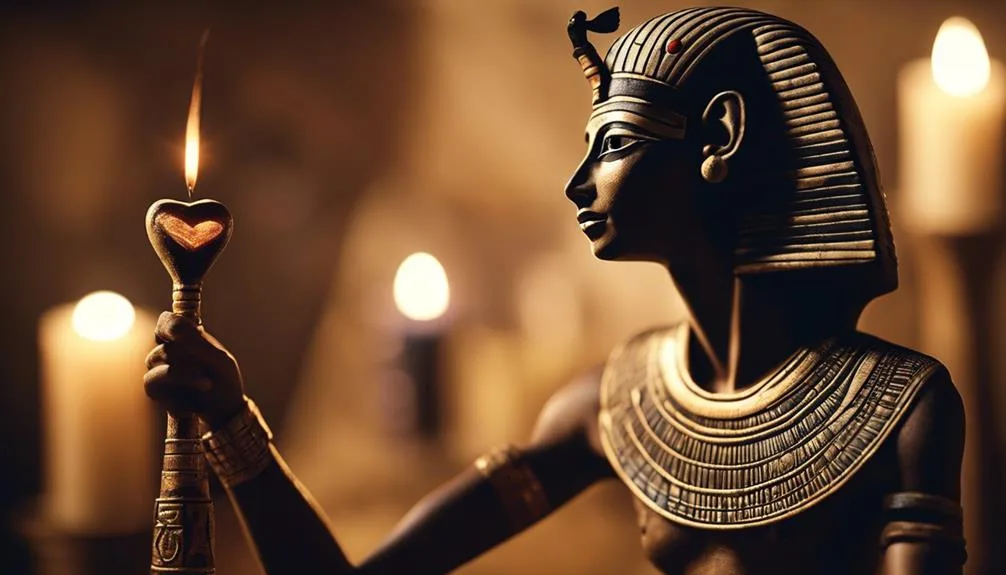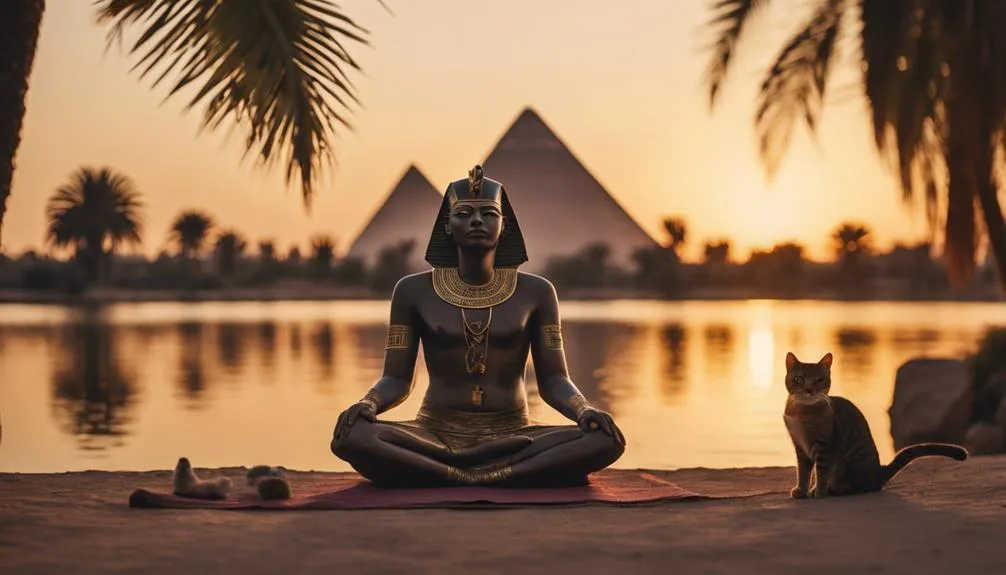Ancient Egyptian Rituals: The Role of Mindfulness
As they say, a journey of a thousand miles begins with a single step, and your exploration into ancient Egyptian rituals is no exception.
You're about to uncover how mindfulness wasn't just a practice but a cornerstone of spirituality that influenced daily life, from the simplest peasant to the Pharaoh himself.
Imagine engaging in rituals that transcend time, connecting you with a civilization renowned for its mystique and wisdom.
Now, picture yourself uncovering the secrets of achieving cosmic harmony through these ancient practices.
Intrigued? Let's embark on this journey together, where the past's echoes may just illuminate the path to your inner peace.
Key Takeaways
- Ancient Egyptian rituals incorporated mindfulness to align spirit with Maat, fostering cosmic balance.
- Meditation techniques, including breath control and visualization, were central to achieving spiritual enlightenment.
- Sacred symbols and spaces played a crucial role in facilitating a deep connection with divine energies.
- Modern application of these ancient practices can enhance focus, reduce stress, and promote emotional well-being.
Kemetic Meditation Origins
Delving into the origins of Kemetic Meditation, one discovers that this practice, rooted in ancient Egypt or Kemet, wasn't merely a form of spiritual engagement but a cornerstone of the societal and religious ethos that shaped the civilization's worldview.
This ancient form of meditation was intricately woven into the cultural and religious fabric of the society, serving as a vital conduit for communing with deities and accessing ancient wisdom. As you explore further, it becomes evident that Kemetic Meditation was much more than a mere practice; it was an essential element of daily life, offering tranquility and guidance amidst the challenges of existence.
This meditation practice aimed to forge a profound connection between the individual and the divine, facilitating a journey towards inner peace and enlightenment. By engaging in Kemetic Meditation, individuals weren't only seeking personal enlightenment but were also participating in a tradition that reinforced the collective identity and spiritual heritage of their community.
It's clear that the ancient forms of meditation practiced in Kemet weren't static rituals but dynamic processes that evolved with the civilization, remaining relevant and offering timeless wisdom to those who seek it today.
Daily Rituals and Mindfulness
In Ancient Egyptian society, daily rituals intricately incorporated mindfulness practices to foster a deep spiritual awareness and forge a connection with the divine. These rituals, far beyond mere ceremonial acts, were steeped in meditation practices that demanded focused attention. Participants, especially priests and priestesses, engaged in symbolic actions, prayers, and offerings with a conscientious presence, aiming to harmonize their spirit with Maat— the fundamental principle of truth, order, and universal balance.
Through these mindful daily rituals, individuals not only sought to maintain cosmic balance but also to align themselves with the cyclical nature of life, death, and rebirth. This alignment was critical in reflecting the ancient Egyptians' beliefs and their understanding of the universe's interconnectedness. By elevating their consciousness and purifying their intentions, participants were able to tap into a higher spiritual depth, seeking guidance and wisdom from the spiritual realm.
Mindfulness in these rituals wasn't a passive act but an active pursuit of spiritual depth. It was a way to live out the principles of Maat in daily life, ensuring that each action and thought was a step closer to the divine. Through these practices, ancient Egyptians cultivated a profound spiritual awareness that guided their understanding of the world and their place within it.
Understanding Maat

Building on the practices of mindfulness in daily rituals, it's crucial to explore Maat, the cornerstone of ancient Egyptian beliefs, which embodies cosmic balance and harmony. This concept isn't merely a philosophical abstraction but is personified as a goddess representing truth, justice, and order. For the ancient Egyptians, Maat was foundational, ensuring the universe's stability and preventing the descent into chaos.
Understanding Maat is pivotal in your profound spiritual journey, as it transcended mere moral codes to guide ethical behavior, social interactions, and rituals. It demanded a harmonious alignment of actions with the universal principles of balance and order. This alignment wasn't passive; it required active participation in maintaining the cosmic equilibrium, making it integral to the spiritual fabric of ancient Egyptian society.
The essence of Maat, in your path of mindfulness, involves recognizing that your actions contribute to the larger cosmic order. It's a call to internalize these values, ensuring that your daily practices, decisions, and interactions reflect this deep respect for balance and harmony. Thus, understanding Maat isn't just learning about an ancient belief system but engaging in a spiritual journey that resonates with the principles of mindfulness, urging you toward ethical living and universal harmony.
Setting the Sacred Space
Creating a sacred space within ancient Egyptian rituals demanded an intricate blend of symbolic elements and meticulous practices to foster a connection with the divine. As you delve into the nuances of these ancient practices, you'll find that preparing sacred spaces wasn't merely about physical arrangements but also served as a form of meditation, inviting deep mindfulness and spiritual engagement.
To understand the depth of these rituals, consider the following key elements and their symbolic significances:
| Symbol | Significance |
|---|---|
| Ankh | Eternal life and the zest of divine energy |
| Djed Pillar | Stability, durability, and divine connection |
| Eye of Horus | Protection, royal power, and good health |
| Lotus | Purity, rebirth, and the sun |
| Frankincense | Purification and sanctification |
Priests and priestesses meticulously integrated these symbols and aromas, like myrrh and lotus, into the sacred spaces. This deliberate arrangement, coupled with the resonating sound vibrations from chants and drumming, elevated the spiritual ambiance. Such meticulous attention to detail in setting sacred spaces underscores the ancient Egyptians' profound understanding of the symbiotic relationship between the physical environment and spiritual mindfulness.
Step-by-Step Meditation Guide

As you embark on this meditation journey, it's crucial to understand the significance of finding inner peace through meticulously executed breathing techniques. By focusing on slow, deep inhalations and exhalations, you not only center your mind and body but also pave the way for a profound spiritual connection.
Furthermore, integrating visualization of ancient Egyptian symbols and deities into your practice enhances the protective and guiding aspects of your meditation, grounding it in the rich tapestry of Egyptian mindfulness rituals.
Finding Inner Peace
To achieve a state of inner peace, begin by selecting a serene environment where you can comfortably engage in meditation without distractions. This initial step is crucial for fostering conditions conducive to a deep meditative state, which can lead to spiritual awakening.
Once settled, close your eyes and turn your focus inward, concentrating on your breath to anchor your mind. This act of centering is pivotal. Subsequently, immerse yourself in visualization, conjuring images of tranquility that enhance your inner calm.
Mindfulness practice, observing your thoughts impartially, further deepens this experience, allowing a detachment from transient mental activity. Finally, reorienting to your environment with this newfound peace marks the culmination of a process that harmonizes the mind, body, and spirit, embodying the essence of ancient wisdom in the pursuit of tranquility.
Breathing Techniques Explained
Having established the foundational role of a serene environment and mental focus in initiating meditation, we'll now explore the ancient Egyptian breathing techniques that further facilitate a deep meditative state. These techniques, pivotal for attaining mindfulness and spiritual alignment, involved a series of structured steps to promote relaxation and focus.
| Step | Action | Purpose |
|---|---|---|
| 1 | Deep Inhalation | To gather cosmic energy and prepare the mind. |
| 2 | Controlled Exhalation | To release bodily tensions and mental distractions. |
| 3 | Steady Breath Holding | To achieve spiritual alignment and inner clarity. |
Through meticulous breath control, individuals sought to harmonize body, mind, and spirit, accessing higher states of consciousness for holistic well-being. This pathway was deemed essential for connecting with the divine and achieving a profound meditative state.
Visualization in Meditation
Delving deeper into ancient Egyptian meditation practices, the technique of visualization plays a pivotal role in connecting practitioners with the spiritual realm through the power of mental imagery. By picturing sacred symbols such as the Ankh, Djed Pillar, and Eye of Horus, individuals sought to channel divine energies and achieve a higher state of consciousness.
Visualization techniques extended to imagining serene natural settings, enhancing the meditative experience with a sense of peace and tranquility. This practice wasn't merely about personal calm but aimed to forge a profound connection with deities like Osiris, Isis, and Thoth, seeking their guidance and wisdom.
Hieroglyphs and temple inscriptions illustrate that through visualization, practitioners aspired to invoke cosmic harmony and balance, endeavoring for spiritual enlightenment.
Integrating Meditation Into Life

Integrating meditation into one's daily routine, as practiced by ancient Egyptians, fosters spiritual growth and inner peace through deliberate focus and awareness. This ancient society understood the profound impact that mindfulness techniques could have on an individual's spiritual life. By allocating sacred spaces for meditation, they created environments that were conducive not only to introspection but also to communion with deities. These practices were essential for maintaining a balanced and harmonious life.
The ancient Egyptians incorporated symbols like the Ankh, Djed Pillar, and Eye of Horus into their meditation techniques, enriching the experience and deepening their connection to divine energies. This integration of symbolism into daily rituals underscores the holistic approach taken towards meditation; it wasn't seen as a separate activity but as a part of life's fabric, intertwining with every action and decision.
Kemetic Meditation, in particular, emphasized the alignment of mind, body, and spirit. This holistic approach to meditation was aimed at achieving spiritual evolution and well-being. By adopting these practices, individuals could enhance their focus, awareness, and ultimately, their connection to the cosmos. This ancient wisdom highlights the timeless value of incorporating meditation into daily life for spiritual and personal growth.
Modern Relevance and Applications
You'll find that the ancient mindfulness practices of Egypt, when applied to your daily life, offer significant contemporary benefits.
These time-honored techniques not only enhance your focus and productivity but also improve your emotional well-being and mental clarity.
Mindfulness in Daily Life
In today's fast-paced world, incorporating mindfulness into daily life offers a transformative approach to enhancing one's mental and emotional well-being.
Mindfulness practices like mindful breathing and body scans can unlock the transformative power of meditation, leading you toward inner peace.
Research highlights its role in reducing stress, sharpening mental clarity, and improving emotional regulation.
Applying mindfulness in various settings, including work and relationships, enhances focus and productivity, fostering a more fulfilling life.
Regular mindfulness practice cultivates resilience, improves decision-making, and deepens connections with oneself and others.
Ancient Practices, Contemporary Benefits
Exploring ancient Egyptian practices, such as Kemetic Meditation, offers contemporary individuals a unique opportunity to connect with a profound source of wisdom, addressing modern challenges with insights rooted in the past. You'll find that incorporating Kemetic Meditation into your daily life not only enhances mental clarity and reduces stress but also improves your emotional well-being. It's a bridge to sustainable spirituality, deeply rooted in the traditions of ancient Egyptians.
| Benefit | Description | Origin |
|---|---|---|
| Tranquility | Achieve inner peace | Ancient Egyptian practices |
| Mental Clarity | Enhanced focus and understanding | Meditation in Ancient Egyptian |
| Stress Reduction | Lower levels of stress | Kemetic techniques |
| Emotional Well-being | Improved emotional state | Ancient wisdom |
| Spiritual Connection | Deeper spiritual awareness | Ancient Egyptians |
Frequently Asked Questions
What Rituals Did Ancient Egyptians Have?
Ancient Egyptians performed rituals like animal mummification and agricultural ceremonies, alongside daily offerings, funerary rites, and temple hymns. These practices reflected their deep spirituality and reverence for deities, ensuring harmony and protection.
How Did They Treat Mental Health in Ancient Egypt?
In ancient Egypt, mental health treatment involved herbal treatments and interpreting emotional hieroglyphs. Priests and healers focused on a holistic approach, blending physical, spiritual, and mental methods to restore balance and well-being.
Did Egyptians Practice Meditation?
Didn't you know? Meditation's origins trace back to ancient Egypt, where it formed a bridge for spiritual connections. Through breath control and visualization, they sought cosmic harmony, proving meditation's deep roots in their culture.
Why Was Ritual so Important in Ancient Egypt?
Rituals were pivotal in Ancient Egypt for divine communication and ensuring social cohesion. They bridged the human and divine, fostering unity and maintaining cosmic balance, crucial for societal prosperity and individual well-being.
Conclusion
In conclusion, the ancient Egyptian practice of mindfulness, deeply rooted in Kemetic meditation, offers a timeless portal to achieving harmony.
As you embark on this path, embracing Maat's principles and cultivating sacred spaces, you're not merely adopting rituals; you're initiating a profound dialogue with the cosmos.
Integrating these practices into your life doesn't just promise tranquility but beckons a transformative journey.
Will you heed this ancient call, unlocking mysteries veiled for millennia? The answer lies within, awaiting your discovery.






